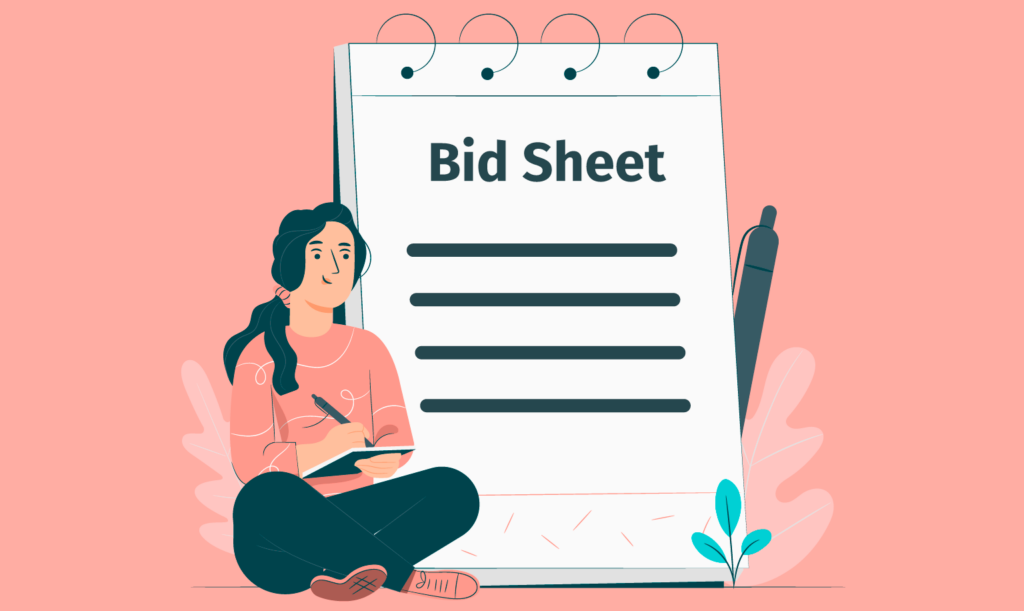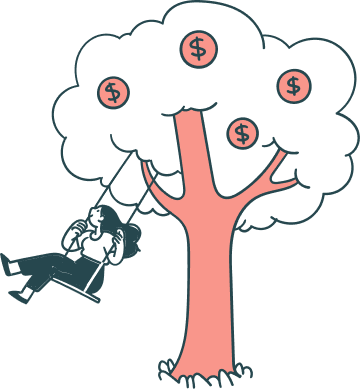Auctions, whether live, silent, in-person, or online, can generate significant funds for nonprofits. There are plenty of reasons to choose a silent auction as your next fundraiser, from the fundraising potential to building a sense of community among supporters to partnering with local businesses. But to reap these benefits, your nonprofit must provide a positive experience for attendees.
Silent auction bid sheets facilitate the bidding process for both donors and your nonprofit, making them a vital component of the auction planning process.
If you’re not sure where to start, don’t worry! We’ll cover each of these topics in detail:
- What Are Silent Auction Bid Sheets?
- What to Include in an Auction Bid Sheet
- Free Silent Auction Bid Sheet Template
- Silent Auction Bid Sheet Best Practices
Bid sheets aren’t overly complicated, but they contain a lot of important information. Let’s explore the basics to ensure your bidding sheets represent your nonprofit in the best way possible.
What Are Silent Auction Bid Sheets?
Silent auction bid sheets detail information about each item in a nonprofit auction and provide space for bidders to list their names and bid amounts. These sheets can be physically printed and placed in front of auction items or virtually created and filled out online.
Auction bid sheets both influence the amount that attendees decide to bid and event management for nonprofit teams. Here’s how both bidders and event organizers can use them:
How Do Bidders Use Them?
Here’s what the silent auction will look like for your attendees when using bid sheets:
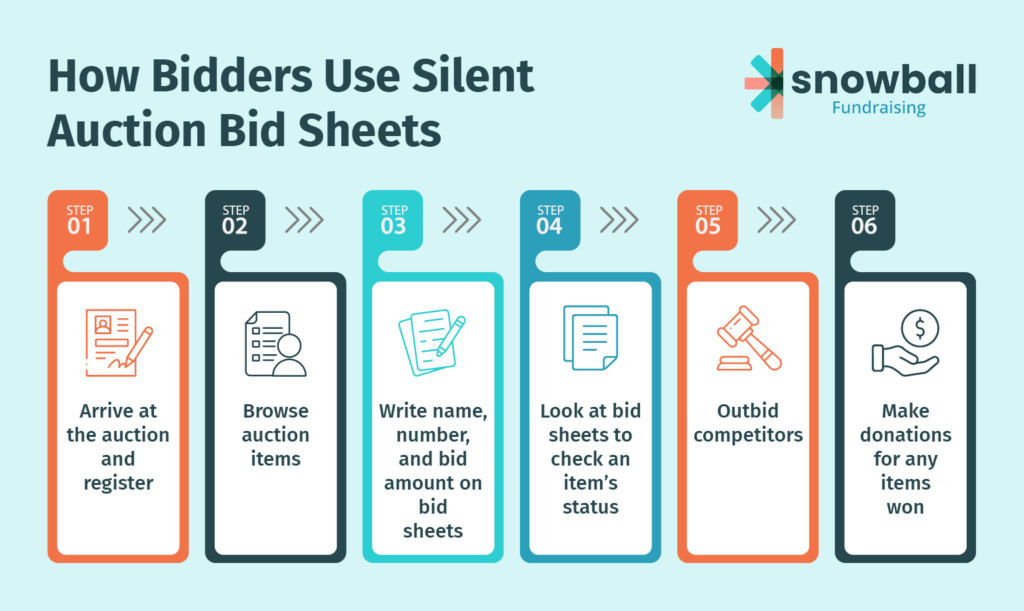
- Arrive at the auction, register, and get a number from the organizers.
- Walk around the space to peruse items, and start making decisions about what items to bid on.
- Write their name, number, and bid amount on each chosen item’s bid sheet.
- Check the status of items throughout the auction by looking at bid sheets.
- Increase bids by writing a new entry on the bid sheet if they see that someone outbids them.
- Make donations for any items that they won and take home the prize at the end of the auction.
In case any of your guests are attending an auction for the first time, include information about how the process works in your promotional materials. For example, you could create a set of branded social media graphics that explain each of these steps and post them on your organization’s Instagram page. This way, you’ll promote your event and help your supporters feel prepared at the same time.
How Do Event Organizers Use Them?
Organizers use bid sheets to track auction progress, determine the highest bidder, and close bidding for an item at any point during the auction. Here are the steps your nonprofit’s team will take on the auction day when using bid sheets:
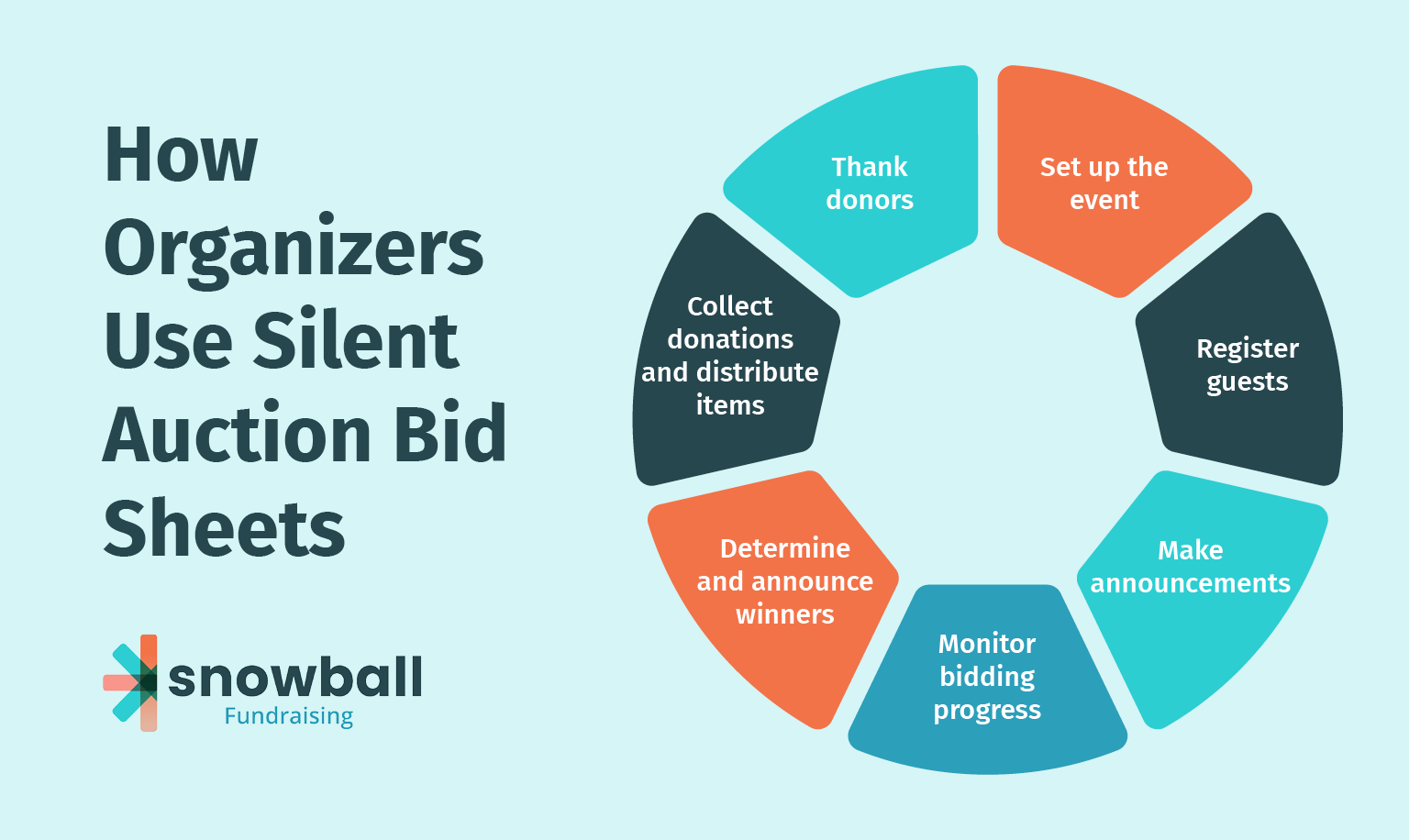
- Set up: Arrange your items in an organized way throughout the event space, being careful not to crowd them together. Label each of the items and place the corresponding bid sheets nearby. Be sure to set out plenty of pens!
- Register guests: You’ll need plenty of volunteers to run your auction successfully. One of their most important roles during the event is to collect guests’ contact information as they arrive and assign them their bidder numbers. You’ll need this information to be organized and easily accessible when you distribute items at the end of the auction.
- Make announcements: Communicate start and end times at the beginning of the event so everyone knows what to expect. Then, announce the remaining time throughout the night.
- Monitor bidding progress: Volunteers should walk the floor of the auction and check bid sheets to see each item’s progress. If anyone bids an item’s guaranteed purchase price, close out the item and note the winner immediately.
- Determine and announce winners: Once the time for bidding ends, collect all of your bid sheets and determine the highest bidder for each item. Then announce the winners! Let attendees know the total funds raised for your campaign. This is a great moment to remind them of your organization’s mission and what their donations will help you achieve.
- Collect donations and distribute items: Call the winners up individually to process payments and hand out their prizes.
- Thank your donors: Be sure to thank every attendee for participating in the auction and donating to your cause. eCardWidget’s guide to donor retention recommends thanking donors within 48 hours of the event to help them feel valued by your organization.
Remember, filling out a bid sheet for each item when you receive it makes the set-up process much easier on the day of the auction. Also, in the weeks and months after your silent auction, evaluate your success and brainstorm ways you can make your next auction even better.
How To Create Virtual Auction Bid Sheets
Online silent auctions work the same way as in-person silent auctions, except guests view and bid on everything online instead of writing bids on physical bid sheets.
Using an online auction platform, you’ll set up a virtual catalog of items that attendees can browse from their phones or computers. As they bid, the website will track bidding progress and update automatically with the current highest bidder. This catalog is where you’ll create your virtual bid sheets.
To create bid sheets for virtual auctions, your organization first needs to choose a charity auction website that offers online and mobile bidding features. Your auction software should include virtual bid sheets that you can easily customize with item information.
Snowball’s auction software sets you up with clear, intuitive virtual bid sheets with plenty of customization options. For each item, add up to five photos and the item description. Then, add all of the same information you’d put on a physical bid sheet, such as the name of the donor, the starting bid amount, and the guaranteed purchase price. You can even place items into categories so guests can find items more easily.
Here’s an example of what your virtual bid sheet might look like using Snowball’s online auction platform:
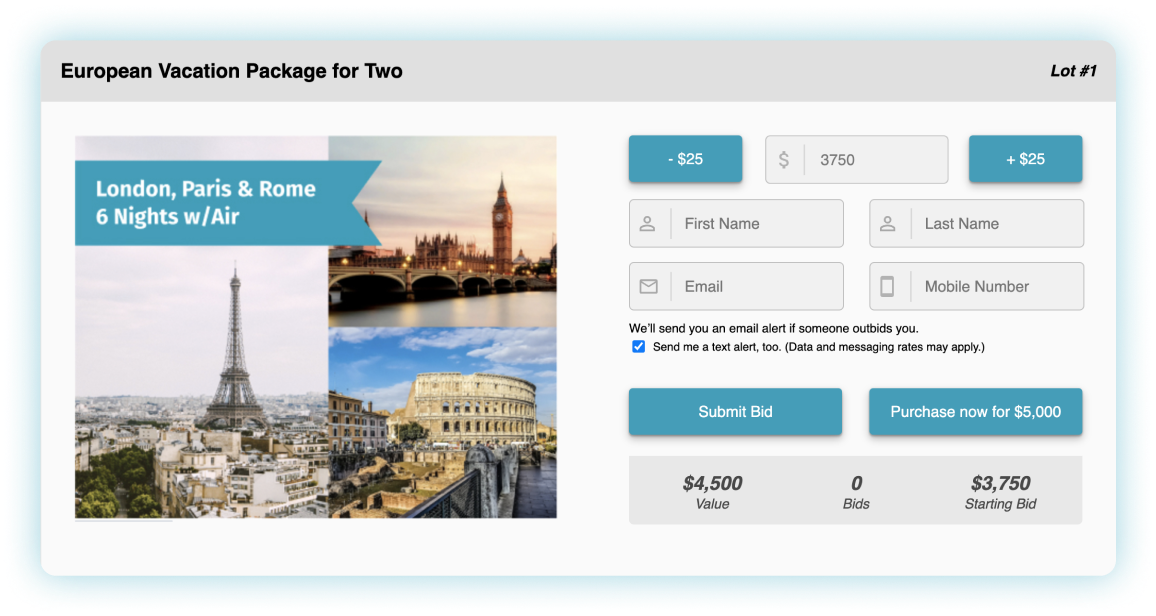
Once your nonprofit has prepared its virtual catalog with information about each item, guests can begin bidding! This bidding can take place at a certain date and time just like an in-person auction, or you can set a more open-ended run time, such as multiple days or even weeks.
When guests are ready to bid, here’s how they can use their bid sheets:
- Guests explore your catalog of virtual bid sheets.
- Bidding starts! Attendees can bid online or using Text-to-Bid.
- Your auction website updates automatically and notifies bidders via email or text if another guest outbids them.
- At the close of the auction, winners are notified virtually and make their donation through a secure online payment portal.
If your nonprofit doesn’t want to go fully virtual, but you still want the ease of online auction functionality and the benefits of mobile giving, consider implementing a Text-to-Bid element to your in-person auction. Give guests the option to write down their bids on bid sheets or text in their bids at any time. Just remember to have volunteers update their physical bid sheets with the highest bid so everyone remains on the same page.
What to Include in an Auction Bid Sheet
During your event, guests should be focused on competing for auction items, not puzzled by the bidding process. Label everything clearly on your bid sheets to make it easy for them to participate and avoid any confusion. Here are the essential elements your auction bid sheet should include:
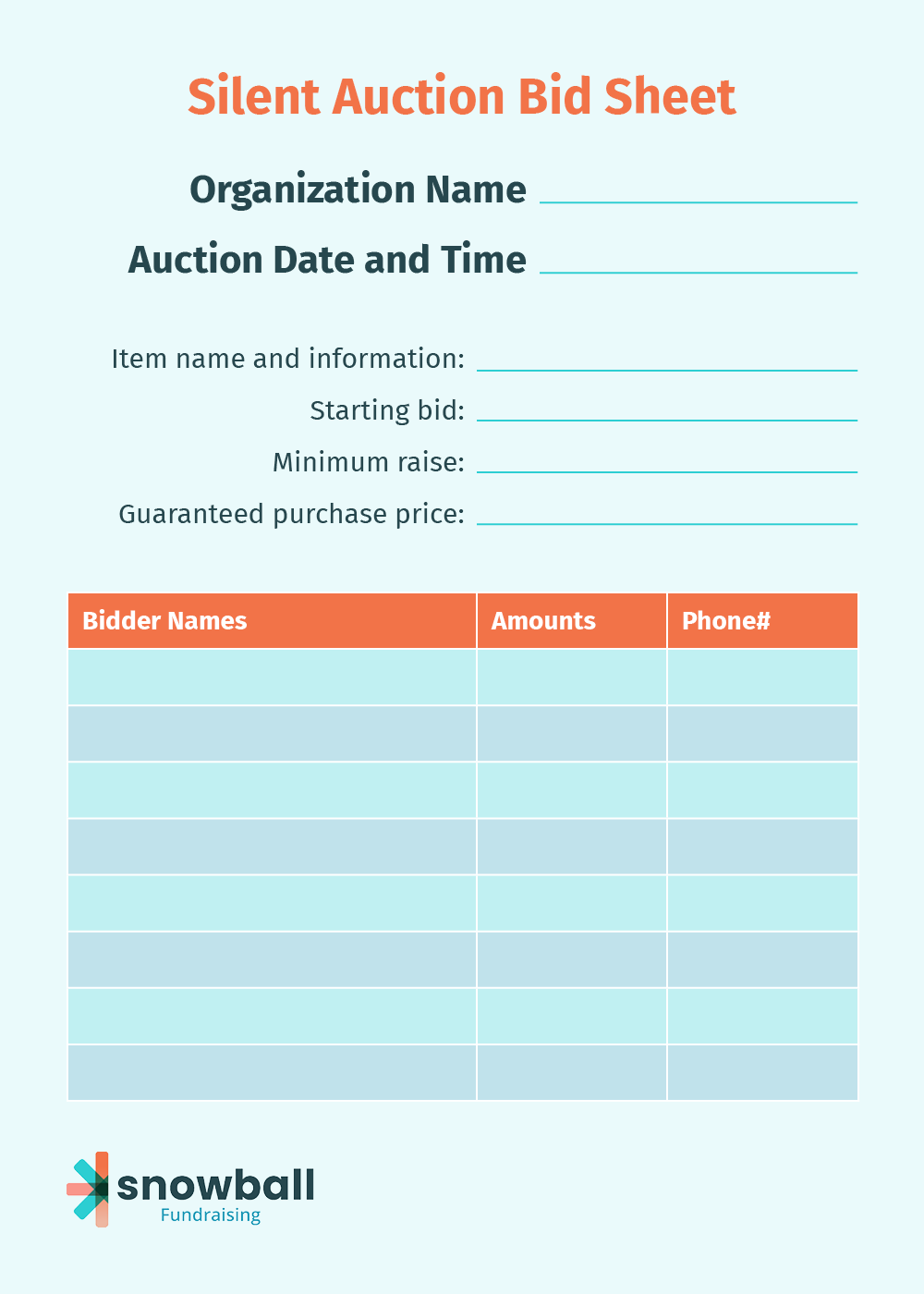
- Item name and information: The name of the item should be clearly listed at the top of the bidding sheet. Below, include a short description of the item, its retail value, the item number, and who donated it. Including the name of the person or business that donated each item gives them not only recognition for their donation but also valuable promotion for their business.
- Starting bid: You can list the starting bid with the other item information at the top of the bid sheet, but we recommend placing it in the first line of the table with bidder names and amounts. This will make it more obvious for attendees and prevent them from accidentally bidding too low.
- Minimum raise: Each new bid must be higher than the last by a minimum number of dollars. The minimum raise will be different depending on each item’s value, so be sure to label this number clearly.
- Guaranteed purchase price: Also known as the “buy now” price, this is the bid amount that can end all bidding for an item immediately. While this is completely optional, it may allow you to more easily reach your fundraising goal for certain items. To determine the guaranteed purchase price, multiply the retail value by 150 to 200%.
- Space for bidder names, bid amounts, and contact information: The number of rows will depend on the size of your event, but we recommend leaving at least 10 blank rows. Asking for a phone number or email address ensures that you can reach the winning bidder even if they leave the event early.
Ensure that these fields are organized and labeled with clear directions, and use a readable, appropriately sized font. Remember that the right auction software can make the design process easy, or offer templates so you don’t have to play with the design at all!
Once you’ve filled out a bid sheet for each of your items, create labels or name cards to place next to the items on display at the event. These should match the item names exactly as they’re listed on the bid sheets.
Free Silent Auction Bid Sheet Template
To simplify your auction planning, we’ve put together a one-size-fits-all solution that you can use to easily fill in information about each of your auction items.
Silent Auction Bid Sheet Best Practices
Even with the perfect silent auction bid sheet template, there’s still more you can do to make them work in your organization’s favor. Follow these best practices to use your silent auction bid sheets effectively:
- Brand your bid sheet to your organization. Include your organization’s name and logo at the top of every bid sheet. If making your own template, align your bid sheet with your nonprofit’s branding. Use the same fonts and colors you use across your regular communications so that your bid sheets remind donors of the cause that they’re supporting.
- Make minimum raises at least 10%. To drive higher bids and more donations for your nonprofit, make each item’s minimum raise 10% to 15% of its retail value. That way, bidders can’t outbid someone else by bidding just five more dollars.
- Consider color coding your bid sheets. You can color code bid sheets for groups of related items so that guests will be able to find other items they’re interested in easily. Or, you can color code items and bid sheets based on retail value. With this system, attendees can focus on the items in their preferred price range.
Also, consider providing an option for anonymity. Leave blanks only for bidder numbers, instead of names and contact information. For the process to work correctly, however, your volunteers need to be diligent about assigning every attendee a number and collecting contact information as guests arrive.
Final Thoughts On Silent Auction Bid Sheets
Now that you understand the basics of silent auction bid sheets, you have everything you need to host a successful silent auction, whether virtual, hybrid, or in-person! Check out these additional resources to expand your knowledge of general auction best practices:
- Virtual Auctions: How to Plan A Fruitful Event in 5 Steps. Virtual auctions can be more convenient, cost-effective, and fun! Learn how to plan a successful event in this guide.
- Auction Items | 101 Best Ideas [& Tips for Procuring Them]. Need ideas for what type of items to auction off at your event? Get inspired by our list of over 100 options.
- Mobile Donations Made Easy: The Ultimate Text-to-Give Guide. If you’re looking for additional fundraising activities to add to your silent auction, mobile giving is the way to go! Check out this full guide to mobile giving for more information.

